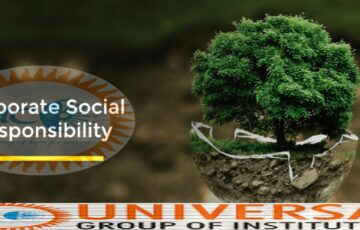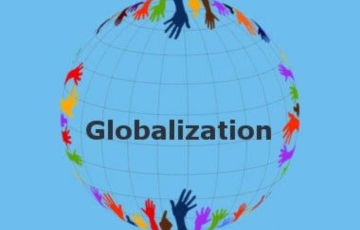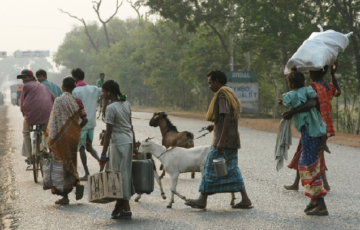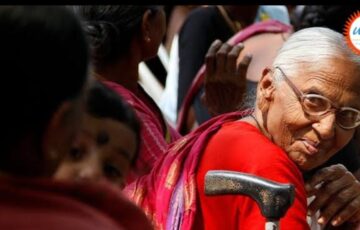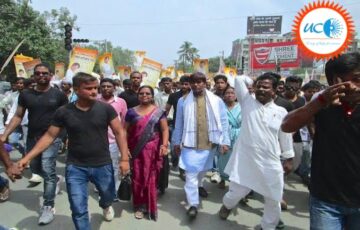Government Of India Initiatives For Women Empowerment
Article 14-16 (under Right to Equality – Article 14-18) of the Indian Constitution lays down equal rights for men and women. Any form of discrimination based on gender is strictly prohibited. Women in India got suffrage rights during India’s independence in 1947, much earlier than most of the Western countries granted to their women citizens the right to vote.
Gender equality is much talked about in contemporary discourse and women empowerment is one of the most critical aspects to achieving it. Men, women, transgender deserve equal opportunities in the field of education, health, economic participation and personal development.
Countries, mostly in northern Europe like Finland, Iceland, Norway, New Zealand and Sweden have made progress in minimising the gender gap but most of the countries in West Asia, South Asia and Africa (mostly the developing and underdeveloped) still face socio-economic disparity and gender gap looms large.
India has been making efforts to end gender gaps and has launched various schemes and projects that work towards empowering women. Some of the efforts by the Indian government are briefed as under.
1) The Dowry Prohibition Act, 1961: “It intended to receiving or giving of a dowry by either party to the marriage either by parents or anyone else associated with marriage”. It applies to people belonging to all religion in India. “The Indian Penal Code was modified in 1983 to establish specific crimes of dowry-related cruelty, dowry death, and abetment of suicide”. It punished violence against women by their husbands or their relatives when they could show the proof of dowry demands or dowry harassment. The legislation underwent an amendment in 1984 which specified the presents given to either bride or a groom at the time of marriage that are allowed.
2) National Plan of Action For the Girl Child (1991-2000): This is a specially formulated action plan by the Government of India to protect and promote the Girl Child. It was introduced to prevent female foeticide and infanticide, eliminate gender discrimination, provide safe drinking water and fodder near homes, rehabilitate and protect girls from exploitation, assault and abuse.
3) National Commission for Women (1992): It was established as a statutory body in January 1992 under the National Commission for Women Act 1990 (Act No. 20 of 1990 of Govt. of India. The Central government held consultations with NGOs, social workers and experts related to the structure, powers and functions of the Commission proposed to be set up. In 1990, the Bill was introduced in the Lok Sabha and in August 1990, the government made several amendments and introduced new provisions to vest the commission with the power of a civil court. Finally, on August 30, 1990, the Bill received President’s assent. Therefore, on January 31st 1992, the First Commission was constituted with Mrs. Jayanti Patna as the Chairperson. Presently, the Chairperson of the NCW is Rekha Sharma who assumed office on 7th August 2018. The Commission was established “to review the constitutional and legal safeguards for women; recommend remedial legislative measures; facilitate redressal of grievances and advise the Government on all policy matters affecting women. It took up the issue of child marriage, sponsored legal awareness programmes, Parivarik Mahila Lok Adalats and reviewed laws such as Dowry Prohibition Act, 1961, PNDT (Pre-natal Diagnostic Technique) Act 1994, Indian Penal Code 1860 and the National Commission for Women Act, 1990 to make them more stringent and effective”.
4) The Protection of Women from Domestic Violence Act, 2005: It has been enacted to criminalize instances of dowry and domestic violence. This Act gives the legal definition of ‘domestic violence’ under Section 3. It is a civil law that focuses on the “reliefs given to the aggrieved women such as compensation, protection, right to residence in the shared household”. Domestic violence covers, mental as well as physical abuse, and also threats to do the same. Any form of harassment, coercion, harm to health, safety or well-being is covered under this Act.
5) The Maternity Benefit Amendment Act 2017 for the private sector: This Act came into force from 1st April 2017. It is an Amendment to the Maternity Benefit Act of 1961. Under this Act, the government increased paid maternity leave from 12 weeks to 26 weeks. It extended certain benefits to mothers who adopt a child as well and provides that “every woman who adopts a child shall be entitled to 12 weeks of maternity leave, from the date of adoption”. “It introduced a provision relating to ‘work from home for women, which may be exercised after the expiry of the 26 weeks’ leave period”. “The Act makes mandatory creche facility for every establishment employing 50 or more employees”. The Act also makes it mandatory for employers to educate women about the maternity benefits available to them at the time of their appointment.
6) The Women’s Reservation Bill: It proposes to amend the Constitution of India to gives 33% reservation for women seats in the Lok Sabha (lower house of the Parliament) and all state legislative assemblies. This is an attempt to increase women’s political participation. The bill was first introduced on 12 September 1996 by the United Front government of Deve Gowda. Successive governments tried to push for the bill but it took 14 years to get it passed in the Rajya Sabha on 9 March 2010. The bill has yet to be passed in the Lok Sabha.
7) National Policy for the Empowerment of Women (NPEW): It was adopted in 2001 which states that any forms of violence against women, physical and mental, at domestic or societal levels, including those arising from customs, traditions or accepted practices shall be dealt effectively with a view to eliminate them. It aimed at creating and strengthening institutions and mechanisms/schemes for assistance and prevention of such violence which also includes sexual harassment at the workplace and customs like dowry; for the rehabilitation of the victims of violence and for taking effective action against the perpetrators of such violence. Emphasis has also been laid on setting up various programmes to deal with trafficking in women and girls.
Under the above policy i.e. NPEW several Women Empowerment Schemes have been formulated by the Ministry of Women and Child Development, India. Some of the schemes are as follows:
a) Beti Bachao Beti Padhao Scheme: It was launched on January 22, 2015, by the P.M of India “to ensure survival, protection and education of the girl child. BBBP is a combination of three ministries- Women and Child Development, Health & Family Welfare and Human Resource Development”. The major objectives are to help remove gender-based discrimination, to protect the girl child and to provide them with education and enabling her participation.
b) One Stop Centre Scheme: Launched on April 1, 2015, it intends to provide 24 hours immediate and emergency response to women affected by the violence, both in private and public spaces. Women Helpline (WHL) has been established in every State and Union Territory to provide integrated support and assistance to women across the country through a single uniform number. These centres will be integrated with 181 along with other existing helplines.
c) Women Helpline Scheme: It came into effect on April 1, 2015. It intends to give 24 hours immediate and emergency response to women affected by the violence, both in private and public spaces. Women Helpline (WHL) has been established in every State and Union Territory to provide integrated support and assistance to women across the country through a single uniform number. Tollfree Women helpline no. 181 has been defined as Unrestricted (shall be accessible from anywhere—national and international.
d) UJJAWALA (1st April 2016): It is a Comprehensive Scheme for Prevention of trafficking and Rescue, Rehabilitation and Re-integration of Victims of Trafficking and Commercial Sexual Exploitation: The scheme is implemented by agencies like the Social Welfare/Women and Child Welfare Department of State Government, Women‟s Development Corporations, Women‟s Development Centres, Urban Local Bodies, reputed Public/Private Trust or Voluntary Organizations. The agency should be registered under the law and must have a properly constituted Managing Body with its powers, duties and responsibilities clearly defined and laid down in its Constitution.
e) Working Women Hostel Scheme: The Government of India had introduced a scheme in 1972-73 of grant-in-aid for construction of new/expansion of existing buildings for providing hostel facilities to working women in cities, smaller towns and also in rural areas where employment opportunities for women exist. This scheme has been revised to promote availability of safe and conveniently located accommodation for working women who need to live away from their families due to professional commitments. The new scheme was launched on April 6th, 2017.
f) SWADHAR Greh (A Scheme for Women in Difficult Circumstances): A scheme which targets the women victims of difficult circumstances who are in need of institutional support for rehabilitation so that they could lead their life with dignity. The Scheme aims to provide shelter, food, clothing and health as well as economic and social security for the aggrieved women.
g) Nari Shakti Puraskar: It is the “annual award given by Ministry of Women and Child Development (Government of India) to individual women or to institutions that work towards the cause of women empowerment”. It is represented by the President of India on International Women’s Day at Rashtrapati Bhavan in New Delhi.
h) Awardees of Stree Shakti Puruskar, 2014: The government of India instituted 5 national awards which are called ‘Stree Shakti Puraskar” — a measure to recognise the achievements of individual women in the field of social development. The award consists of a cash prize of Rs 1 Lakh and a citation. The awards are un the names of eminent women personalities in India history, viz. Devi Ahilya Bai Holkar, Kannagi, Mata Jijabai, Rani Gaidenlou Zeliang and Rani Laxmibai awards.
i) Awardees of Rajya Mahila Samman & Zila Mahila Samman: Conferred from 2015 onwards. These awards would recognise and reward selfless work done by exceptional and committed women at the community and grassroots level. One award one very district and one in each State/UT.
j) Mahila Police Volunteers: “They would act as a link between police and the community and facilitate women in distress. The MPVs will be chosen by the Home Department of the concerned State/UT through the Superintendent of Police of the district. The MPV will directly report to the Circle Inspector in the Police Thana”.
k) Mahila Shakti Kendras (MSK): “For empowering rural women through community participation and to create an environment in which they realize their full potential. It will provide an interface for rural women to approach the government for availing their entitlements also empowering them through training and capacity building”.
l) NIRBHAYA Fund: “For projects specifically designed to improve the safety and security of women. It is a non-lapsable corpus fund, being administered by Department of Economic Affairs, Ministry of Finance.”
Apart from the above schemes, the government of India have set various other plans like Support to Training and Employment Programme for Women (STEP) which aims to address the situation of poor women in remote areas who are not able to move out of their native for skill training. This would help women to be self-employed. The Government of India has planned to train 500 million individuals by 2020.
On the other, the Government of India has tried to collaborate with various international organizations and NGOs. It is the founding member of the International Labour Organization (ILO) and has also ratified approximately 47 protocols and conventions. It has signed the Convention on the Elimination of All Forms of Discrimination against Women (CEDAW) in 1980 and ratified it in 1993. It has yet to ratify the Optional Protocol of the CEDAW and National Action Plan on Women, Peace and Security.
Despite such efforts, it is ranking on global surveys of gender equality has not improved over the years. According to Global Gender Gap Report 2021 by World Economic Forum, India ranks 140th among 156 countries (World Economic Forum, 2021). Given the low ranking on the gender gap, India has to work towards political empowerment which is relatively low as well as economic empowerment which has widened since 2006 (Kapur and Narayan 2020). The Indian legal system has also been seen faltering in terms of protecting women and girls because of corruption and poor enforcement of the law among others. Hence, an extensive and more collaborative approach is required to ensure women empowerment through proper and equitable access to education, employment, health care, and representation — political as well as economic.
References:
Beti Bachao Beti Padhao, Ministry of Women and Child Development, Government of India (2021).
India Code: Digital Repository of All Central and State Acts, The Protection of Women from Domestic Violence.
Ministry of Women and Child Development, Government of India, Revised Guidelines and Application Format in Support to Training and Employment Programme for Women (STEP) 2009. Nirbhaya, Ministry of Women and Child Development, Government of India (2021).
National Commission for Women: Official Website.
Nari Shakti Puraskar and Stree Shakti Puraskar, Ministry of Women and Child Development, Government of India.
One Stop Centre Scheme: Implementation Guidelines for State Governments/UT Administration (2017), Ministry of Women and Child Development, Government of India.
Singh, Aanchal (2018), “What is Domestic Violence? An introduction to the Protection of Women from Domestic Violence Act, 2005, The Leaflet-Constitution First.
Swadhar Grew Scheme, Ministry of Women and Child Development, Government of India (2021).
The Wire (2021), “India Slips 28 Places in WEF’s Gender Gap Index, Ranked 140th Among 156 Nations”, 1 April 2021.
UJJAWALA: A Comprehensive Scheme for Prevention of Trafficking and Rescue, Rehabilitation and Re-Integration of Victims of Trafficking for Commercial Sexual Exploitation, Effective 1st April 2016, Ministry of Women and Child Development, Government of India.
Women Helpline Scheme, Ministry of Women and Child Development, Government of India (2021).
World Economic Forum (2021), Global Gender Gap Report 2021: Insight Report, Geneva.
Working Women Hostel, Ministry of Women and Child Development, Government of India.



